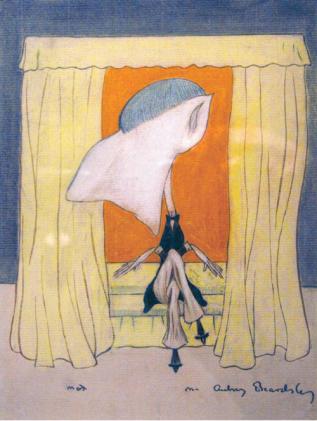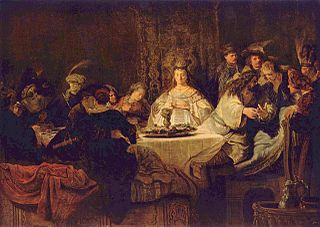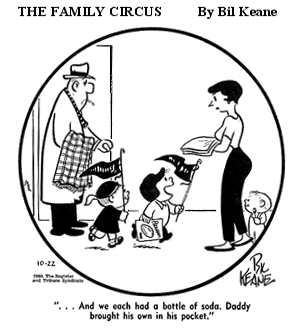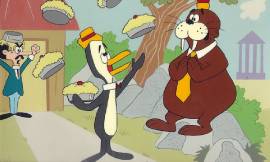
Droodles was a syndicated cartoon feature created by Roger Price and collected in his 1953 book Droodles, though the term is now used more generally of similar visual riddles.

Droodles was a syndicated cartoon feature created by Roger Price and collected in his 1953 book Droodles, though the term is now used more generally of similar visual riddles.
The general form is minimal: a square box containing a few abstract pictorial elements with a caption (or several) giving a humorous explanation of the picture's subject. For example, a Droodle depicting three concentric shapes –little circle, medium circle, big square –might have the caption "Aerial view of a cowboy in a Port-a-john." [1]
The trademarked name "Droodle" suggests "doodle", "drawing" and "riddle". [2] However, the form of the droodle –a riddle expressed in visual form –has earlier roots, for example in a drawing (indovinelli grafici) by the Italian painter Agostino Carracci (1557–1602), and the term is widely used beyond Price's work. [3]
Droodles are (or were) purely a form of entertainment like any other nonsense cartoon and appeared in roughly the same places (newspapers, paperback collections, bathroom walls) during their heyday in the 1950s and 1960s. The commercial success of Price's collections of Droodles led to the founding of the publishing house Price-Stern-Sloan, and also to the creation of a Droodles-themed game show, Droodles, on NBC in 1954. [4] There was also a droodle-based game called "Mysteriosos" on HBO's Braingames . Series of newspaper advertisements for the News and Max brands of cigarettes featured cigarette-themed Droodles. [1]
One of Price's original Droodles serves as the cover art for Frank Zappa's 1982 album Ship Arriving Too Late to Save a Drowning Witch . Price's other captions for that drawing include "Mother pyramid feeding her baby."
Pictures in a similar style feature in The Little Prince by Antoine de Saint-Exupéry. [3]
By the end of Roberto Bolaño's long novel The Savage Detectives the mysterious works by the lost poetess Cesárea Tinajero turn out to be a short series of mexican culture visual puns, similar to Price's Droodles.

Animation is a filmmaking technique by which still images are manipulated to create moving images. In traditional animation, images are drawn or painted by hand on transparent celluloid sheets (cels) to be photographed and exhibited on film. Animation has been recognized as an artistic medium, specifically within the entertainment industry. Many animations are computer animations made with computer-generated imagery (CGI). Stop motion animation, in particular claymation, has continued to exist alongside these other forms.
A comic strip is a sequence of cartoons, arranged in interrelated panels to display brief humor or form a narrative, often serialized, with text in balloons and captions. Traditionally, throughout the 20th and into the 21st century, these have been published in newspapers and magazines, with daily horizontal strips printed in black-and-white in newspapers, while Sunday papers offered longer sequences in special color comics sections. With the advent of the internet, online comic strips began to appear as webcomics.

A cartoon is a type of visual art that is typically drawn, frequently animated, in an unrealistic or semi-realistic style. The specific meaning has evolved, but the modern usage usually refers to either: an image or series of images intended for satire, caricature, or humor; or a motion picture that relies on a sequence of illustrations for its animation. Someone who creates cartoons in the first sense is called a cartoonist, and in the second sense they are usually called an animator.

Comics is a medium used to express ideas with images, often combined with text or other visual information. It typically takes the form of a sequence of panels of images. Textual devices such as speech balloons, captions, and onomatopoeia can indicate dialogue, narration, sound effects, or other information. There is no consensus among theorists and historians on a definition of comics; some emphasize the combination of images and text, some sequentiality or other image relations, and others historical aspects such as mass reproduction or the use of recurring characters. Cartooning and other forms of illustration are the most common image-making means in comics; Photo comics is a form that uses photographic images. Common forms include comic strips, editorial and gag cartoons, and comic books. Since the late 20th century, bound volumes such as graphic novels, comic albums, and tankōbon have become increasingly common, along with webcomics as well as scientific/medical comics.

The Far Side is a single-panel comic created by Gary Larson and syndicated by Chronicle Features and then Universal Press Syndicate, which ran from December 31, 1979, to January 1, 1995. Its surrealistic humor is often based on uncomfortable social situations, improbable events, an anthropomorphic view of the world, logical fallacies, impending bizarre disasters, references to proverbs, or the search for meaning in life. Larson's frequent use of animals and nature in the comic is popularly attributed to his background in biology. The Far Side was ultimately carried by more than 1,900 daily newspapers, translated into 17 languages, and collected into calendars, greeting cards, and 23 compilation books, and reruns are still carried in many newspapers. After a 25-year hiatus, in July 2020 Larson began drawing new Far Side strips offered through the comic's official website.

A caricature is a rendered image showing the features of its subject in a simplified or exaggerated way through sketching, pencil strokes, or other artistic drawings. Caricatures can be either insulting or complimentary, and can serve a political purpose, be drawn solely for entertainment, or for a combination of both. Caricatures of politicians are commonly used in newspapers and news magazines as political cartoons, while caricatures of movie stars are often found in entertainment magazines.

Roger Law is a British caricaturist, ceramist and one half of Luck and Flaw, creators of the popular satirical TV puppet show Spitting Image.

A riddle is a statement, question or phrase having a double or veiled meaning, put forth as a puzzle to be solved. Riddles are of two types: enigmas, which are problems generally expressed in metaphorical or allegorical language that require ingenuity and careful thinking for their solution, and conundra, which are questions relying for their effects on punning in either the question or the answer.

The Family Circus is a syndicated comic strip created by cartoonist Bil Keane and, since Keane's death in 2011, is written, inked and rendered (colored) by his son Jeff Keane. The strip generally uses a single captioned panel with a round border, hence the original name of the series, which was changed following objections from the magazine Family Circle. The series debuted on February 29, 1960 and has been in continuous production ever since. According to publisher King Features Syndicate, it is the most widely syndicated cartoon panel in the world, appearing in 1,500 newspapers. Compilations of Family Circus comic strips have sold more than 13 million copies worldwide.

Psychedelic art is art, graphics or visual displays related to or inspired by psychedelic experiences and hallucinations known to follow the ingestion of psychedelic drugs such as LSD, psilocybin, and DMT. The word "psychedelic" means "mind manifesting". By that definition, all artistic efforts to depict the inner world of the psyche may be considered "psychedelic".
Roger Price was an American humorist, author and publisher, who created Droodles in the 1950s, followed by his collaborations with Leonard B. Stern on the Mad Libs series. Price and Stern became partners with Larry Sloan in the publishing firm Price Stern Sloan.

The newspaper riddle is a riddle joke or conundrum in English that begins with the question:

McCurdy's was a Rochester, New York–based department store. Founded in 1901, the company was acquired by May Department Stores in 1994, but as a result of an antitrust settlement due to both McCurdy's and May's Kaufmann's stores being the predominant anchors in the area shopping malls, its stores were divested to The Bon-Ton Department store chain.

Out Our Way was an American single-panel comic strip series by Canadian-American comic strip artist J. R. Williams. Distributed by Newspaper Enterprise Association, the cartoon series was noted for its depiction of American rural life and the various activities and regular routines of families in small towns. The panel introduced a cast of continuing characters, including the cowboy Curly and ranch bookkeeper Wes. Out Our Way ran from 1922 to 1977, at its peak appearing in more than 700 newspapers.
The history of comics has followed different paths in different parts of the world. It can be traced back to early precursors such as Trajan's Column, in Rome, Egyptian hieroglyphs and the Bayeux Tapestry.

Tennessee Tuxedo and His Tales is an animated television series that originally aired Saturday mornings on CBS from 1963 to 1966 as one of the earliest Saturday morning cartoons. It was produced by Total Television, the same company that produced the earlier King Leonardo and the later Underdog, and primarily sponsored by General Mills. A co-sponsor was Pillsbury's Funny Face Drinks. The title is a play on the “tuxedo” dinner jacket worn as formal wear.
Comics has developed specialized terminology. Several attempts have been made to formalize and define the terminology of comics by authors such as Will Eisner, Scott McCloud, R. C. Harvey and Dylan Horrocks. Much of the terminology in English is under dispute, so this page will list and describe the most common terms used in comics.
A caption contest or caption competition is a competition between multiple participants, who are required to give the best description for a certain image offered by the contest organizer. Rules and information about the competition process are also given by the competition organizer.

The Nazi Party and its ideological allies used cartoons and caricatures as a main pillar in their propaganda campaigns. Such techniques were an effective way to spread their ideology throughout Nazi Germany and beyond. The use of caricatures was a popular method within the party when pursuing their campaign against the United States, in particular its then-President Franklin D. Roosevelt.

The corpus of traditional riddles from the Finnic-speaking world is fairly unitary, though eastern Finnish-speaking regions show particular influence of Russian Orthodox Christianity and Slavonic riddle culture. The Finnish for 'riddle' is arvoitus, related to the verb arvata and arpa.